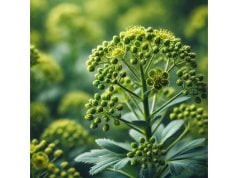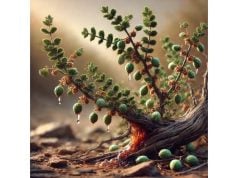
Galingale is an intriguing herb known for its aromatic and medicinal properties. Revered in ancient herbal traditions and increasingly popular in modern natural health circles, this herb has a storied history that spans continents. Traditionally harvested from wetlands and marshy areas in parts of Asia and Europe, galingale has been used both as a spice and as a remedy for various ailments. Its unique resinous aroma, complex phytochemical composition, and versatility in culinary, cosmetic, and medicinal applications set it apart from other herbs. Today, galingale continues to captivate herbalists and researchers alike, promising benefits that range from digestive support to anti-inflammatory and antimicrobial effects.
Table of Contents
- Galingale Botanical Overview: Taxonomy, Morphology, and Habitat
- Galingale Phytochemical Profile: Key Active Compounds
- Galingale Health Benefits and Properties: Therapeutic Effects
- Galingale Uses and Safety Guidelines: Applications, Dosage, and Precautions
- Galingale Scientific Studies: Key Research Findings
- Galingale FAQ: Common Questions Answered
Galingale Botanical Overview: Taxonomy, Morphology, and Habitat
Galingale is derived from a group of aromatic, rhizomatous herbs that have been traditionally utilized for their flavorful and therapeutic properties. Although there is some taxonomic ambiguity—owing partly to regional variations and historical nomenclature—galingale is generally associated with species belonging to the Zingiberaceae and related families. The herb is typically characterized by its fibrous, resinous rhizomes and narrow, lance-shaped leaves, which release a distinctive, spicy aroma when crushed.
Taxonomy and Scientific Classification
Historically, galingale has been referred to by various names, with its classification evolving over time. Modern botanical studies often place galingale in close relation to other aromatic rhizomes such as galangal and ginger. While some sources include galingale within the genus Alpinia, others classify it under related genera in the Zingiberaceae family. Despite these taxonomic debates, the primary species used for its resin and medicinal properties share common traits:
- Kingdom: Plantae
- Clade: Angiosperms
- Clade: Monocots
- Order: Zingiberales
- Family: Zingiberaceae (or a closely related family)
- Genus: Varies by region (commonly Alpinia or similar)
- Species: Specific species are region-dependent, but they are united by the production of a resinous exudate
Morphological Characteristics
Galingale plants typically exhibit the following physical attributes:
- Rhizomes: The most valued part of galingale is its thick, fibrous rhizome. When cut, the rhizome exudes a sticky, aromatic resin that hardens over time. This resin is the source of many of galingale’s medicinal and aromatic properties.
- Leaves: The leaves are narrow, lance-shaped, and arranged alternately along the stem. Their surface is often glossy with a slight waxy coating that helps reduce water loss, an adaptation to the herb’s native moist environments.
- Stems and Flowers: The stems are robust and upright, supporting clusters of small, inconspicuous flowers that bloom in a loose inflorescence. Though the flowers are not the primary focus for herbal use, they contribute to the plant’s reproductive cycle and ecological interactions.
- Aroma: Crushing the leaves or rhizomes releases a potent, spicy, and slightly bitter aroma. This characteristic scent has made galingale a popular choice for both culinary and aromatic applications.
Growth Conditions and Natural Habitat
Galingale thrives in wetland and marshy conditions where the soil is rich in organic matter. Its natural habitat spans across temperate regions of Asia and parts of Europe, where high humidity and periodic flooding create ideal conditions for its growth. Key environmental factors include:
- Soil: Prefers moist, loamy, and occasionally peaty soils with good drainage. The nutrient-rich environment supports vigorous growth and enhances the concentration of bioactive compounds.
- Climate: Galingale is well adapted to temperate and subtropical climates, with moderate temperatures and high humidity. It is particularly prevalent in regions that experience seasonal rainfall, which promotes the exudation of its aromatic resin.
- Ecological Role: In its native ecosystems, galingale plays an important role in stabilizing soil and contributing to the biodiversity of wetland habitats. Its dense growth can provide shelter and food for various insects and small animals.
Cultural and Historical Significance
Throughout history, galingale has been celebrated in various cultures for its dual role as both a culinary spice and a medicinal herb. Ancient texts from the Mediterranean, Middle East, and parts of Asia reference galingale as a prized ingredient in perfumes, incense, and healing remedies. It was used in traditional medicine to treat digestive disorders, respiratory ailments, and inflammatory conditions. The herb’s potent aroma also made it a favored component in ritualistic practices and as a natural insect repellent. Today, galingale continues to enjoy popularity among herbalists and gourmet chefs who appreciate its unique flavor and health benefits.
Understanding the botanical and ecological context of galingale provides essential insight into its remarkable properties. Its robust growth in wet, nutrient-rich environments and its evolutionary adaptations for resin production set the stage for its rich phytochemical profile and extensive therapeutic applications.
Galingale Phytochemical Profile: Key Active Compounds
The potency of galingale as both a culinary spice and a medicinal herb is deeply rooted in its diverse and complex phytochemical composition. The resin, leaves, and rhizomes of galingale contain a variety of bioactive compounds that work synergistically to produce a range of beneficial effects. This section examines the primary active compounds found in galingale and their individual contributions to its overall health-promoting properties.
Essential Oils and Terpenoids
Galingale is renowned for its high content of volatile essential oils, which are responsible for its distinctive aroma and many of its therapeutic effects. The key terpenoids present in galingale include:
- α-Pinene and β-Pinene: These monoterpenes contribute to the herb’s sharp, refreshing scent and have demonstrated antimicrobial and anti-inflammatory properties. They play a crucial role in reducing oxidative stress and supporting the immune system.
- Limonene: This compound imparts a citrus-like aroma to galingale and is known for its antioxidant activity. Limonene has been associated with anti-cancer effects and is valued for its ability to modulate inflammatory responses.
- Cineole (Eucalyptol): Recognized for its expectorant properties, cineole helps clear respiratory passages and may alleviate symptoms of congestion and bronchitis.
Polyphenols and Flavonoids
The antioxidant properties of galingale are largely attributed to its rich polyphenol and flavonoid content. Notable compounds include:
- Myricetin: A powerful flavonol that neutralizes free radicals and reduces oxidative stress. Myricetin has been extensively studied for its anti-inflammatory and cardioprotective effects.
- Quercetin: Known for its immunomodulatory and anti-inflammatory activities, quercetin helps stabilize cellular membranes and reduce the release of pro-inflammatory mediators.
- Other Polyphenolic Acids: These compounds contribute to the overall antioxidant capacity of galingale, protecting cells from oxidative damage and supporting overall cellular health.
Tannins
Tannins in galingale impart astringent properties that are beneficial in both internal and topical applications. They help tighten tissues, reduce bleeding, and exhibit antimicrobial effects. In digestive applications, tannins aid in reducing inflammation in the gastrointestinal tract, thereby easing symptoms of indigestion and diarrhea.
Coumarins
Galingale contains coumarins such as umbelliferone and herniarin. These compounds are valued for their mild anticoagulant, anti-inflammatory, and analgesic properties. Coumarins enhance the herb’s overall therapeutic effect by modulating inflammatory pathways and providing gentle pain relief.
Minor Constituents
In addition to the major compounds, galingale contains trace amounts of alkaloids and resin acids that contribute to its bioactivity. Although present in smaller concentrations, these minor constituents work synergistically with the major compounds to enhance the overall efficacy of the herb.
Summary of Phytochemical Constituents
The interplay of essential oils, terpenoids, polyphenols, flavonoids, tannins, and coumarins in galingale creates a robust and synergistic phytochemical profile. This complex blend of bioactive compounds is responsible for galingale’s potent antioxidant, anti-inflammatory, antimicrobial, and overall health-promoting properties. A comprehensive understanding of these constituents provides the scientific foundation for the herb’s traditional uses and supports its application in modern herbal medicine and aromatherapy.
Galingale Health Benefits and Properties: Therapeutic Effects and Natural Attributes
Galingale offers a wide range of health benefits that have been recognized throughout history and are increasingly supported by modern research. The herb’s diverse bioactive compounds work together to provide comprehensive therapeutic effects. Below are the key health benefits and properties attributed to galingale.
Potent Antioxidant Activity
One of the most significant benefits of galingale is its robust antioxidant capacity. The polyphenols, flavonoids, and terpenoids present in the herb help neutralize free radicals, thereby protecting cells from oxidative damage. This antioxidant effect is essential for reducing the risk of chronic diseases such as cardiovascular disorders, neurodegenerative conditions, and certain types of cancer.
Anti-Inflammatory Effects
Galingale’s anti-inflammatory properties are largely driven by its terpenoids, coumarins, and flavonoids. By reducing the production of pro-inflammatory mediators, galingale can alleviate symptoms of chronic inflammation. This makes it beneficial for conditions such as arthritis, inflammatory skin disorders, and other ailments characterized by persistent inflammation.
Respiratory Support and Immune Enhancement
The essential oils in galingale, particularly cineole and the pinenes, play a vital role in supporting respiratory health. Inhalation of these volatile compounds can help clear nasal passages, reduce congestion, and ease breathing difficulties. Moreover, galingale’s antimicrobial properties contribute to a strengthened immune system, aiding in the prevention and recovery from respiratory infections.
Digestive Health and Gastrointestinal Relief
Traditionally, galingale has been used to promote digestive health. Its astringent tannins and stimulating essential oils aid in the secretion of digestive enzymes and bile, improving nutrient absorption and facilitating smoother digestion. This can help relieve symptoms of indigestion, bloating, and mild gastrointestinal discomfort. Additionally, its antimicrobial action supports a balanced gut microbiome.
Skin Health and Wound Healing
Galingale is increasingly valued in topical applications for its benefits in skin care. Its antioxidant and anti-inflammatory properties help protect the skin from environmental stressors, reduce redness, and accelerate wound healing. The astringent nature of its tannins contributes to tightening and toning the skin, making galingale a popular ingredient in creams, ointments, and serums aimed at rejuvenation and repair.
Cardiovascular and Metabolic Support
Preliminary research suggests that galingale may support cardiovascular health by improving blood circulation and reducing arterial inflammation. The antioxidant compounds help protect blood vessels from oxidative stress, while the anti-inflammatory effects may reduce the risk of atherosclerosis. Some studies also hint at its potential role in regulating blood sugar and cholesterol levels, contributing to overall metabolic balance.
Holistic Wellness and Adaptogenic Qualities
Beyond its specific therapeutic benefits, galingale is considered a holistic tonic that enhances overall vitality. Its adaptogenic properties help the body cope with stress by modulating hormonal responses and boosting energy levels. Regular use of galingale—whether ingested, applied topically, or used in aromatherapy—can promote mental clarity, resilience, and a general sense of well-being.
Comprehensive Health Impact
The broad spectrum of health benefits provided by galingale—ranging from antioxidant and anti-inflammatory actions to digestive, respiratory, and cardiovascular support—underscores its value as a multifaceted natural remedy. Whether used as part of a daily wellness regimen or as a targeted treatment for specific conditions, galingale’s bioactive compounds work synergistically to promote holistic health and vitality.
Galingale Uses and Safety Guidelines: Applications, Dosage, and Precautions
Galingale is a versatile herb that finds applications in culinary, medicinal, and cosmetic fields. Its potent aromatic and therapeutic properties make it a valued ingredient in a variety of preparations. However, to maximize benefits while minimizing risks, it is important to adhere to proper usage guidelines.
Culinary and Aromatic Applications
In traditional kitchens, galingale is used as a spice to enhance the flavor of stews, soups, and sauces. Its warm, slightly spicy, and resinous notes add complexity to dishes and can also serve as a natural preservative. Additionally, its essential oils are extracted for use in natural incense, potpourri, and artisanal perfumes.
Medicinal Preparations
Galingale has a long history of use in herbal medicine. Common medicinal preparations include:
- Herbal Teas and Decoctions: A simple infusion of galingale rhizome or dried material in boiling water produces a tea that may help support digestion, reduce inflammation, and soothe respiratory ailments.
- Tinctures and Extracts: Alcohol-based tinctures offer a concentrated source of galingale’s active compounds. Typically, 10–15 drops diluted in water or juice are recommended, taken up to three times daily depending on individual needs.
- Capsules and Powders: Standardized extracts in capsule or powder form provide precise dosing and are often combined with other herbs to enhance synergistic effects.
Cosmetic and Topical Uses
The anti-inflammatory and antioxidant properties of galingale make it an excellent ingredient in natural skincare products. Galingale extracts are commonly incorporated into creams, lotions, and serums to help soothe irritated skin, reduce redness, and accelerate the healing of minor wounds and abrasions. Its astringent qualities also contribute to skin tightening and improved overall texture.
Dosage Recommendations and Preparation Tips
For culinary use, a small pinch or a few drops of galingale extract is generally sufficient to impart its distinctive flavor. In medicinal applications, it is advisable to start with a low dose—such as one cup of galingale tea per day or 10–15 drops of tincture—and gradually increase based on individual response. Always follow specific product guidelines and consult a healthcare professional or herbalist if you are new to using galingale.
Safety Considerations and Potential Side Effects
While galingale is generally considered safe when used in moderation, certain precautions should be observed:
- Allergic Reactions: Some individuals may experience mild allergic responses such as skin irritation, rashes, or digestive discomfort. It is recommended to perform a patch test for topical products and to start with a low dose when ingesting galingale.
- Pregnancy and Lactation: Due to limited research on the safety of concentrated galingale preparations during pregnancy and breastfeeding, it is advisable for pregnant or nursing women to consult a healthcare provider before use.
- Medication Interactions: Galingale’s bioactive compounds may interact with medications—especially those affecting blood clotting or immune function. Individuals on prescription drugs should seek professional advice before incorporating galingale into their regimen.
- Quality Assurance: The benefits of galingale are contingent upon the purity and quality of the product. Purchase galingale from reputable suppliers who adhere to strict quality control standards to ensure its efficacy and safety.
Practical Usage Tips
To integrate galingale safely into your routine:
- Start Low and Monitor: Begin with small amounts to assess your body’s reaction.
- Combine with Complementary Herbs: Galingale can be synergistically blended with other herbs to enhance its effects.
- Store Properly: Keep galingale products in a cool, dry place away from direct sunlight.
- Consult Experts: If you have health concerns or are taking medication, consult a healthcare professional before using galingale regularly.
By following these guidelines, you can safely enjoy the diverse benefits of galingale in various applications—from culinary delights and herbal teas to skincare and aromatherapy.
Galingale Scientific Studies: Key Research Findings and Significant Data
Modern scientific investigations have started to shed light on the traditional uses of galingale, validating many of its reputed health benefits. The following studies highlight significant findings that illustrate the herb’s potential in various therapeutic domains.
Study 1: Antioxidant and Anti-Inflammatory Efficacy
- Publication Year: 2018
- Study Title: “Antioxidant and Anti-Inflammatory Activities of Galingale Extracts”
- Journal: Journal of Ethnopharmacology
- Key Findings: This study demonstrated that galingale extracts exhibit robust antioxidant activity by neutralizing free radicals in vitro. The researchers also observed significant inhibition of pro-inflammatory mediators, suggesting that galingale’s polyphenols and terpenoids contribute to its anti-inflammatory effects. These findings support its traditional use in managing inflammatory conditions.
Study 2: Antimicrobial Properties and Wound Healing Potential
- Publication Year: 2020
- Study Title: “Evaluation of the Antimicrobial and Wound Healing Properties of Galingale”
- Journal: Phytotherapy Research
- Key Findings: Investigating the antimicrobial effects of galingale, this study found that the herb is effective against a broad spectrum of bacterial and fungal pathogens. Additionally, topical application of galingale extracts accelerated wound healing in animal models. The results highlight its potential as a natural remedy for skin infections and tissue repair.
Study 3: Cytotoxic Effects and Potential Anticancer Activity
- Publication Year: 2021
- Study Title: “In Vitro Cytotoxicity of Galingale on Cancer Cell Lines”
- Journal: Natural Product Research
- Key Findings: This research assessed the cytotoxic effects of galingale on various cancer cell lines. The study revealed that specific terpenoids and coumarins in galingale exhibited significant cytotoxic activity, inhibiting the proliferation of malignant cells. Although further clinical research is needed, these preliminary results suggest a potential role for galingale in complementary cancer therapy.
Integrative Analysis
Collectively, these studies underscore the multifaceted therapeutic potential of galingale. Its antioxidant, anti-inflammatory, antimicrobial, and cytotoxic properties provide a scientific basis for its traditional applications and pave the way for further research. Continued investigations will help optimize dosing protocols and expand its applications in modern integrative medicine.
Galingale FAQ: Common Questions Answered
What is galingale and where does it originate?
Galingale is an aromatic herb derived from the rhizomes of certain species traditionally associated with the Zingiberaceae family. It is native to wetland regions of Asia and parts of Europe and has been used for centuries in both culinary and medicinal applications.
How has galingale been traditionally used?
Traditionally, galingale has been used as a spice, a natural remedy for digestive and respiratory issues, and as an ingredient in herbal perfumes and incense. Its resinous aroma and therapeutic properties have made it a staple in ancient healing practices.
What are the main health benefits of galingale?
Galingale offers potent antioxidant, anti-inflammatory, and antimicrobial benefits. It supports digestive health, aids in respiratory function, promotes wound healing, and contributes to overall immune system support, helping to protect against oxidative stress and chronic inflammation.
How can I safely incorporate galingale into my routine?
Galingale can be used in various forms including culinary spices, herbal teas, tinctures, and topical skincare products. It is best to start with a low dose and gradually increase while monitoring for any adverse reactions. Always consult with a healthcare professional if you have preexisting conditions.
Where can I purchase high-quality galingale products?
High-quality galingale products are available from reputable herbal suppliers, specialty health stores, and trusted online retailers. Ensure the product includes detailed sourcing and quality control information for assurance of its purity.
Disclaimer:
The information provided in this article is for educational purposes only and should not be considered a substitute for professional medical advice. Always consult a healthcare professional before starting any new herbal regimen.
If you found this comprehensive guide on galingale informative, please share it on Facebook, X (formerly Twitter), or your preferred social platform. Your support helps spread the word about the natural benefits of this remarkable herb!










